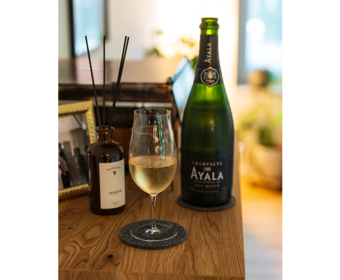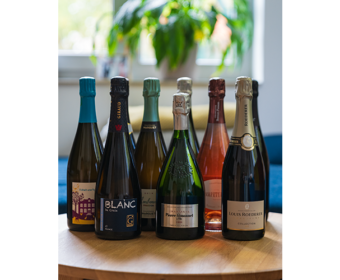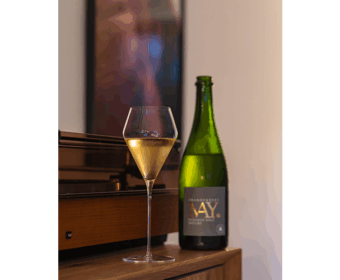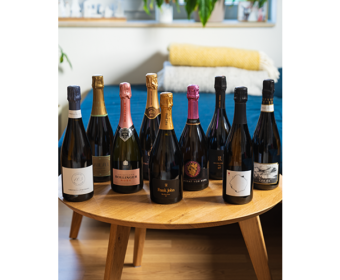A (Dry) Champagne Tasting
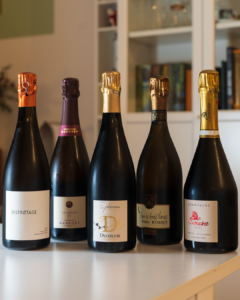
The festive season is approaching fast, and therefore it seems like the perfect time for a little champagne tasting! Since our taste tends towards drier and more natural wines, we focused on small vineyard champagnes. The Dosage ranges from Extra Brut levels to Zero Dosage and three of the five wines we tried also were organically produced. Check out our review, if you are still looking for a bottle of luxurious sparkling wine for Christmas.
De Sousa Cuvée des Caudalies
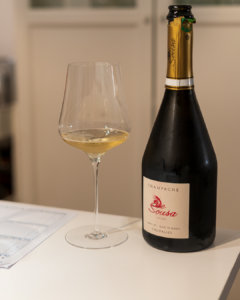
The first sparkling wine we tried was the De Sousa Cuvée des Caudalies Extra Brut. When it comes to Blanc de Blanc champagne, made from 100 % Chardonnay grapes, I always prefer Larmandier Bernier or De Sousa. However, the De Sousa tends to be a bit less dry. De Sousa vinifies their Cuvée des Caudalies 100 % in oak with 15 % new barrels and 50 % reserve wines. The grapes come from organic vineyards in Avize and the Côte des Blancs region from 50-year-old vines. The wine carries out the malolactic fermentation. Furthermore, the champagne is bottled with a Dosage of 5 g / litre.
Winey and round

The delivers everything you would expect from a high-quality Blanc de Blanc. It has some wine notes accompanied by some fruity apple flavour. On top of that, I noticed a hint of exotic fruits, reminding me of pineapples. You definitely can taste the oak with subtle whiffs of smoke, but it does not overwhelm the drinking experience. It is quite complex with a medium Perlage and I enjoyed the champagne very much.
Eric Rodez Cuvée des Grands Vintages

Eric Rodez produces champagne since 1984 and gained experience in Burgundy and at Krug. There he was responsible for the Grand Cuvée. The Cuvée des Grands Vintages is Eric‘s take on the Krug Grand Cuvée, and he blends seven different vintages and eleven Terroirs for it. Eric ferments the grapes in 100 % oak casks and just 5 % of the wine carries out the malolactic fermentation. In the end, a Dosage of just 4 g / litre is added.
Adstringent and mineral

The Grands Vintages polarized the tasters, some enjoyed it very much and others did not enjoy it that much. I guess, this is due to its noticeable acidity with notes of green apples. Apart from that, you can find some flint stones, dark fruits, bee‘s wax and honey in the taste. I also noticed some lactic and even some watercress flavours. Overall, it is a complex wine which absolutely demands your attention.
Dosnon Ephémère 2015
As a Burgundy fan, Davy Dosnon also sought physical proximity to Burgundy. His vineyard in the Aube region is just 40 km from Chablis. For the first fermentation Davy uses small used Barrique-casks and he also vinifies his wines in oak casks afterwards. The Ephémère consists of 100 % Pinot Meunier vinified for ten months in 228 l Burgundy casks and spends 56 months on the yeast. The Ephémère has an Dosage of 2 g / litre.
Effervescent with yeast notes
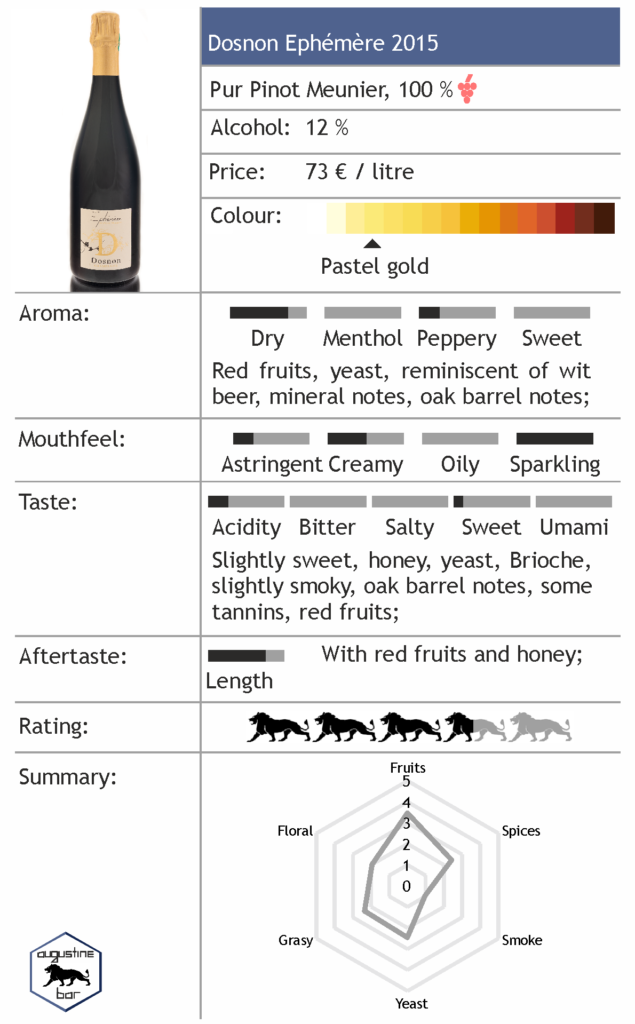
The Dosnon starts with some yeast notes, minerals and some oak notes. Apart from that, you will find some honey and Brioche flavours. However, the Perlage is quite intense with large bubbles. Moreover, the taste reminded me a bit of a wheat beer with some red fruit notes.
Benoit Marguet Shaman 16 Rosé
Benoit Marguet is the fifth generation champagne maker in his family. He has most of his vineyards in Ambonnay and a small portion in Bouzy. The average age of the biodynamically grown vines is 40 years. For the Shaman Rosé Benoit uses a blend of 70 % chardonnay and 30 % pinot noir grapes vinified in wood. The pinot noir comes from vineyards in Ambonnay as well as Bouzy. No Dosage is added to the champagne after Disgorgement.
Complex red fruits
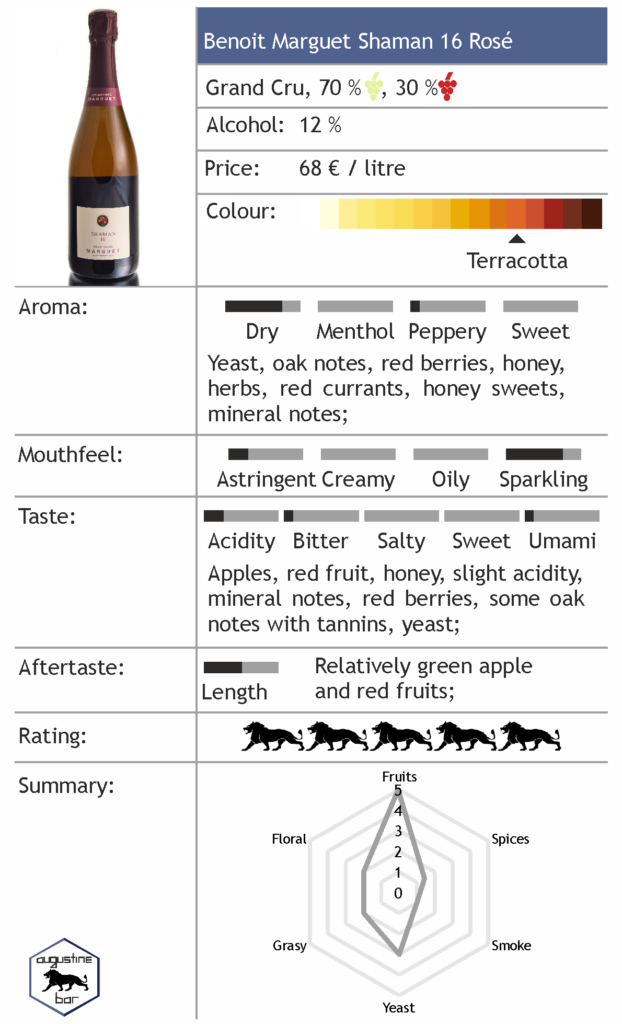
Right away, I can tell you that the Marguet Rosé was my favourite in the tasting! The wine had complex notes of yeast, oak, honey and red fruits. In the taste, you can also find some apple notes, some acidity as well as mineral flavours. Although the wine had a strong Perlage, it consisted of fine effervescent bubbles. You even could taste some tannins in the end and did not miss the Dosage at all.
Dufour BISTROTAGE 2014 Blanc de Noirs
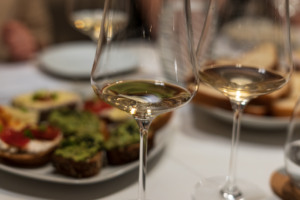
Charles Dufour only makes one champagne, his „Bulles de Comptoir“. However, he also vinifies the best grapes from his mother‘s vineyards and sells them under the „Francoise Martinot“ label. What they have in common is that the grapes are biodynamically grown and no sulphur is added during the production of the wine. In the case of the 2014 Blanc de Noirs, Charles uses small used oak barrels for the first fermentation of the pinot noir grapes from Vallée de l’Arce. Afterwards, the wine is vinified 25 % in stainless steal and 75 % in oak casks. Additionally, the Cuvée consists of 20 % reserve wines from 2011 and 2012. In the end, the champagne is bottled without any Dosage.
Floral, red fruits
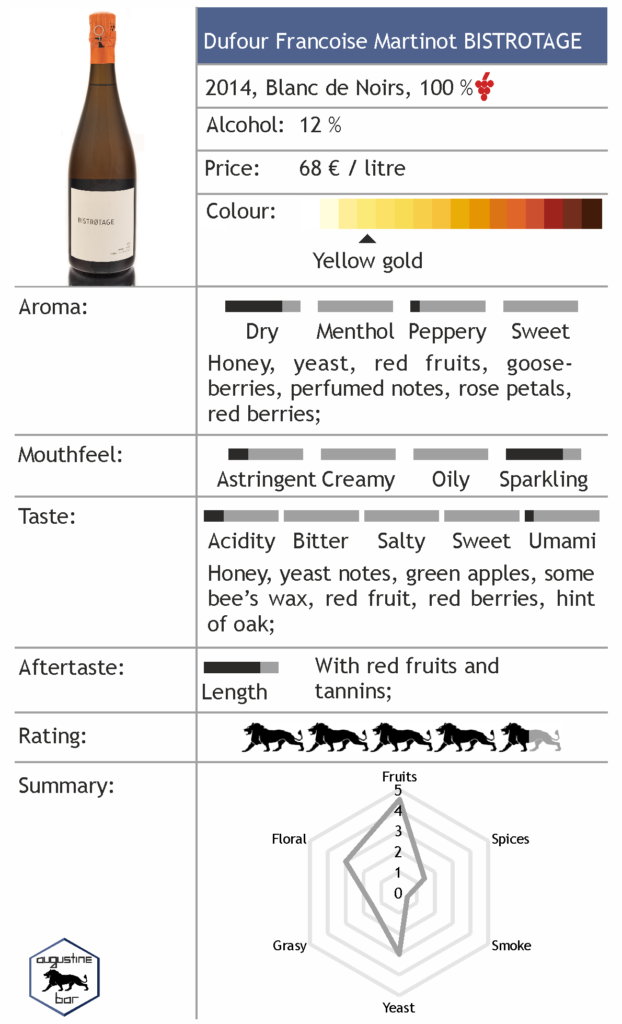
Similar to the Marguet champagne, you do not miss the Dosage at all. Of course, you will notice a certain acidity, but it is very well integrated and reminds me of green apples. Furthermore, the champagne carries honey, red berries and also certain floral flavours. Apart from that, I noticed a bit of bee‘s wax and tannins towards the end of the sip. The Perlage also is quite strong, but also well integrated.

